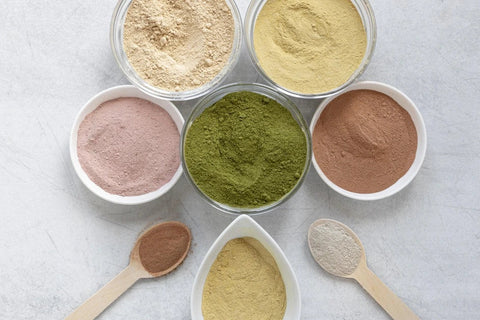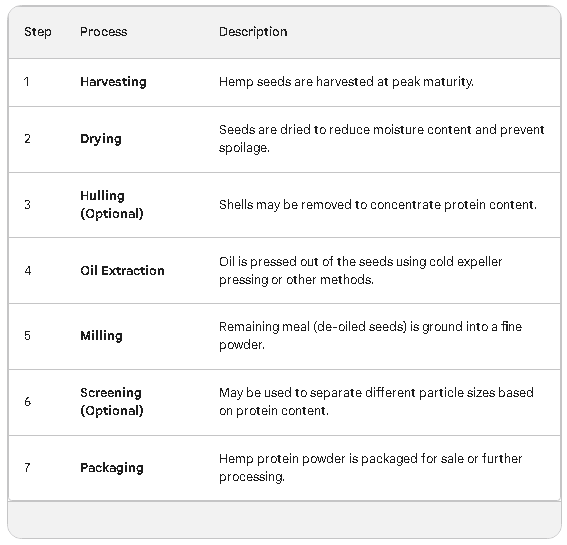Protein powder is a dietary supplement concentrated in protein, extracted from various sources like animal products (milk, eggs) or plants (soy, peas, hemp). It comes in a fine, powdered form, easily mixed with liquids to create shakes, smoothies, or added to other foods. Here's a deeper dive:
Whey Protein
Whey protein is a naturally occurring mixture of several different proteins found in whey.
Whey is the liquid portion that separates from milk curds during cheesemaking.
This liquid contains various components, including lactose (milk sugar), minerals, and whey protein.
Composition:
Whey protein consists of several different protein types, with beta-lactoglobulin, alpha-lactalbumin, bovine serum albumin, and immunoglobulins being the major ones.
It makes up about 20% of the protein in cow's milk, while human milk has a higher proportion (around 60%).
Processing:
Whey protein isn't directly extracted from milk but undergoes various processing steps:
- Filtration: The whey is filtered to remove lactose and other components.
- Concentration and drying: The protein is concentrated and dried into a fine powder.
- Depending on the desired product, various additional processes might be used, such as ion exchange (for whey protein isolate) or hydrolysis (breaking down protein into smaller peptides for easier digestion).
So, what's actually in whey protein powder?
Primarily protein molecules, composed of various amino acids (including all nine essential ones, making it a complete protein).
Depending on the processing method, it might also contain small amounts of:
- Lactose: More in whey protein concentrate, less in isolate and hydrolysate.
- Fat: Trace amounts.
- Carbohydrates: Trace amounts from lactose.
- Minerals: Like calcium, potassium, and sodium.
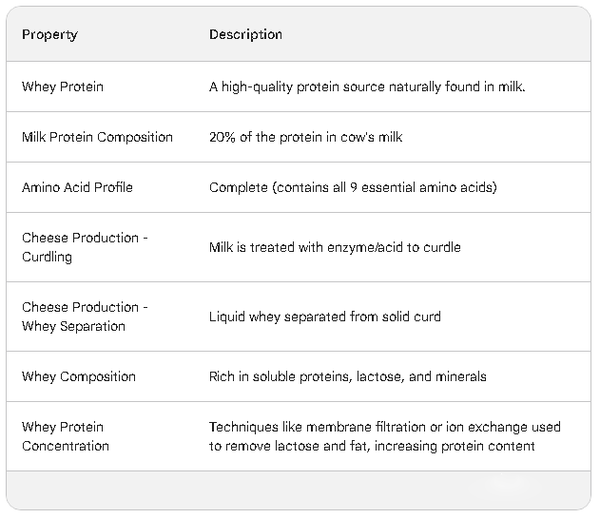
Casein Protein
Casein protein isn't made of anything specifically, as it's not constructed from individual components. Instead, it's a type of protein naturally found in milk, making up about 80% of the milk protein content. It exists in milk as micelles, which are clusters of numerous individual protein molecules linked together.
These individual protein molecules within the micelles are called phosphoproteins, meaning they contain phosphate groups attached to their structure. This gives casein unique properties compared to other protein types, such as:
- Slower digestion: The phosphate groups contribute to casein's slower digestion rate, leading to a sustained release of amino acids into the bloodstream.
- Gel formation: When heated or exposed to acid, casein micelles readily form a gel-like substance. This is why cheese curds form during cheesemaking and why yogurt gets its thicker consistency.
- Hydrophobic nature: Casein is relatively hydrophobic, meaning it doesn't dissolve easily in water on its own. However, it interacts with other milk components to form stable suspensions in milk.
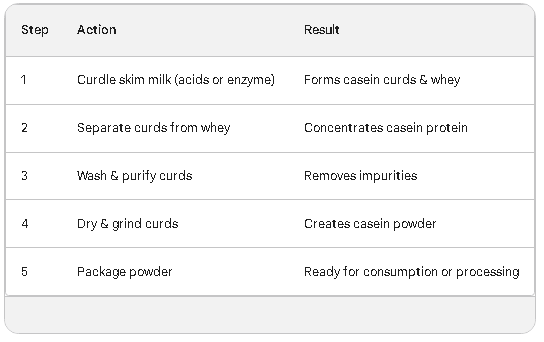
Soy Protein
Soy protein powder is produced from soybeans, but the "making" involves extracting and concentrating the protein itself, not creating it from scratch. Here's a breakdown:
Source:
Starts with dehulled and defatted soybeans, meaning the outer shell and most of the oil are removed.
Processing:
There are three main forms of soy protein powder, each with varying levels of processing:
- Soy protein concentrate (SPC): Around 65-70% protein, retains some fibre and carbohydrates from the soybeans.
- Soy protein isolate (SPI): Typically 90% or more protein, further processed to remove most non-protein components.
- Soy protein flour: Least processed, containing around 50% protein along with other soybean components. While not technically classified as "powder," it can be ground into a finer powder form.
So, what's actually in soy protein powder?
Primarily protein molecules, mainly composed of various amino acids (including all nine essential ones, making it a complete protein).
Depending on the type of powder, it might also contain small amounts of:
- Fibre (more in SPC)
- Carbohydrates (more in SPC and flour)
- Fat (trace amounts)
- Minerals (like calcium, potassium, iron)
Soy protein powder is often unflavoured and unsweetened, but manufacturers may add flavours, sweeteners, and other ingredients.

Pea Protein
Pea protein powder is, as the name suggests, derived from yellow split peas. It's extracted through a series of steps to concentrate the protein content into a fine powder.
The starting point is dried yellow split peas. These have their outer hulls removed, making them easier to process and concentrate the protein.
Processing:
The peas are typically milled into fine flour. This flour undergoes wet processing with water to separate the protein from other components like starch and fibre.
The isolated protein undergoes further processing (like centrifugation and drying) to remove moisture and create a fine, beige powder known as pea protein isolate. This is the most common form of pea protein powder.
Depending on the desired product, other methods might be used:
- Pea protein concentrate: Less processed, containing less protein (60-80%) with some carbs and/or fats.
- Pea protein hydrolysate: Protein is broken down into smaller peptides for easier digestion.
So, what's actually in pea protein powder?
Primarily protein molecules, composed of various amino acids (including all nine essential ones, making it a complete protein).
The amount of protein varies depending on the processing method:
- Isolate: Up to 90% protein
- Concentrate: 60-80% protein
Depending on the type of powder, it might also contain small amounts of:
- Fibre (more in concentrate)
- Carbohydrates (more in concentrate)
- Fat (trace amounts)
- Minerals (like iron, potassium)
Pea protein powder is often unflavoured and unsweetened, but manufacturers may add flavours, sweeteners, and other ingredients.

Rice Protein
Unlike building a dish from ingredients, rice protein powder isn't "made of" something specific, but rather extracted and concentrated from brown or white rice. Here's how it works:
- Grinding: First, the rice grains are milled into a fine powder.
- Enzyme treatment: Enzymes are added to break down the carbohydrates and fats in the rice, leaving behind the protein.
- Isolation and processing: The protein is then isolated, concentrated, and dried into a fine powder. This powder may be further processed to remove any remaining impurities or improve its texture and taste.
So, what's actually in rice protein powder?
Primarily protein molecules are composed of various amino acids (although it's not considered a complete protein as it lacks one essential amino acid, lysine).
Depending on the processing method and source, it might also contain small amounts of:
- Carbohydrates (trace amounts)
- Fibre (trace amounts)
- Fat (trace amounts)
- Minerals (like calcium, iron)
Rice protein powder is often unflavoured and unsweetened, but manufacturers may add flavours, sweeteners, and other ingredients.
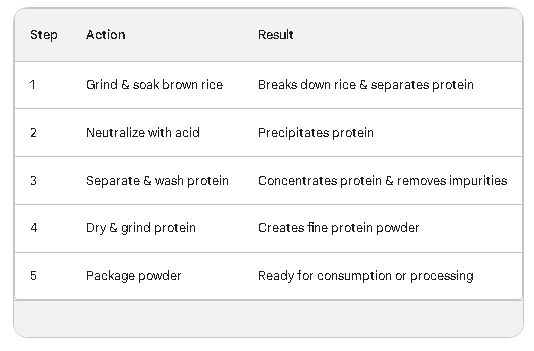
Hemp Protein
Hemp protein powder is, unsurprisingly, made from hemp seeds, those little treasures originating from the hemp plant. But it's not just the whole seed; the protein is specifically extracted and concentrated through a series of steps.
The starting point is raw hemp seeds. These are carefully selected for their high protein content and optimal nutritional profile.
Processing:
- Hulled and defatted: First, the outer shell and most of the oil are removed from the seeds.
- Milling: The remaining seed material is then ground into a fine powder.
- Separation: Some processing methods use water to separate the protein from other components like fibre and carbohydrates.
- Drying: The isolated protein is then dried into a fine powder known as hemp protein powder.
So, what's actually in hemp protein powder?
Primarily protein molecules, composed of various amino acids (including all nine essential ones, making it a complete protein).
Hemp protein powder is known for its high digestibility, which means your body can easily absorb its amino acids.
Depending on the processing method, it might also contain small amounts of:
- Fibre (trace amounts)
- Healthy fats (omega-3, omega-6, and omega-9)
- Minerals (like magnesium, iron, phosphorus)
Hemp protein powder often has a nutty, earthy taste. Some manufacturers may add flavours or sweeteners.
It's also considered a sustainable protein source due to the environmentally friendly nature of hemp cultivation.
Collagen Protein
Collagen protein powder is derived primarily from animal connective tissues (skin, bones, cartilage), unlike most proteins originating from muscles or seeds.
Source:
Primarily comes from the connective tissues of animals like:
- Cows: Bovine collagen is the most common source.
- Chickens: Chicken bone broth can be used to extract collagen.
- Fish: Marine collagen is gaining popularity.
- Even eggshells can be a source of collagen peptides.
Processing:
- Extraction: The collagen is extracted from these animal tissues using various methods, like heat, acids, or enzymes.
- Hydrolysis: Often, the extracted collagen undergoes hydrolysis, a process that breaks down the large collagen molecules into smaller peptides. This makes them easier for your body to absorb.
- Drying and formulation: Finally, the collagen peptides are dried into a fine powder and may be mixed with other ingredients like flavours, sweeteners, or vitamins.
So, what's actually in collagen protein powder?
Primarily collagen peptides, which are smaller building blocks of collagen.
Depending on the source and processing, it might also contain small amounts of:
- Other proteins (in bovine collagen)
- Fat (trace amounts)
- Minerals (like calcium, magnesium)
Collagen protein powder often has a neutral taste and smell.
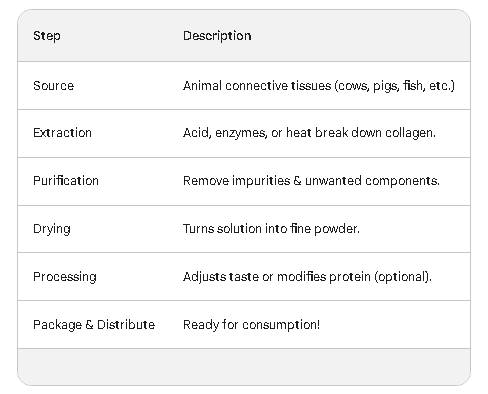
Egg White Protein
Egg white protein powder is exactly what it sounds like – a concentrated powder made from dried egg whites. Here's a breakdown:
Source:
- The protein comes directly from egg whites of chicken eggs.
Composition:
Egg white protein consists of various albumin proteins, with ovalbumin being the most abundant.
There are also other protein types like ovomucoid, ovotransferrin, and ovomucin, each with different functions within the egg.
This protein mixture makes up around 10% of the egg white by weight.
So, what's actually in egg white protein?
Primarily protein molecules, composed of different amino acids (including all nine essential ones, making it a complete protein).
Besides protein, you'll find trace amounts of:
- Water: Egg whites are mostly water, around 90%.
- Carbohydrates: Very small amounts of carbohydrates are present.
- Minerals: Trace amounts of minerals like sodium, potassium, and magnesium.
- Fat: Almost negligible amounts of fat.
Compared to other protein sources, egg white protein is readily digested and absorbed by the body due to its unique structure.
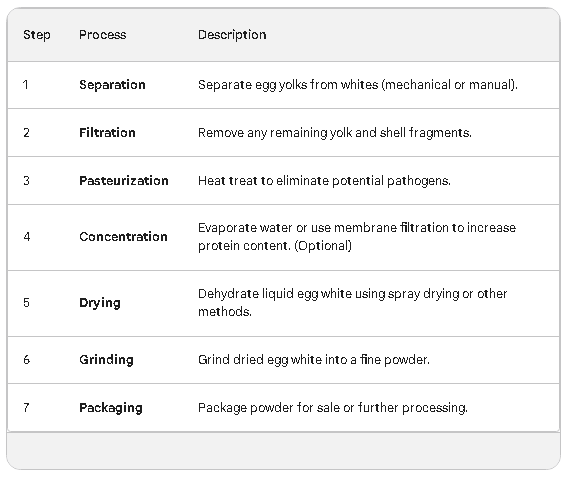
Milk Protein Blend
Milk protein blends can be composed of various combinations of two main milk proteins: whey protein and casein protein. They may also include other beneficial ingredients depending on the specific blend and its intended purpose. Here's a breakdown:
Main components:
- Whey protein: This fast-digesting protein makes up approximately 20% of milk protein. It's known for its rich content of branched-chain amino acids (BCAAs) important for muscle building and recovery.
- Casein protein: This slow-digesting protein makes up about 80% of milk protein. It provides sustained amino acid release, promoting muscle growth and preventing muscle breakdown.
Additional ingredients (depending on the blend):
- Other sources of protein: Some blends may include plant-based proteins like pea, soy, or rice protein alongside milk protein for a more complete amino acid profile.
- Fats: Sometimes healthy fats like MCT oil are added for increased satiety, energy, and potential cognitive benefits.
- Carbohydrates: Some blends may contain complex carbohydrates like oat flour for slow-burning energy or added fibre for digestive health.
- Vitamins and minerals: Certain blends may be fortified with essential vitamins and minerals to fill nutritional gaps.
- Flavours and sweeteners: Flavours and sweeteners are commonly added to improve palatability.
Plant-Based Blends
Plant-based proteins are naturally occurring proteins found in various plant sources. Think of it like different fruits containing different vitamins and minerals, each plant source has its unique protein profile.
Here's what you need to know about plant-based protein sources:
They come from a wide range of plants, including:
- Legumes: Beans, lentils, chickpeas, peas (e.g., green peas, split peas)
- Nuts & Seeds: Almonds, cashews, peanuts, sunflower seeds, hemp seeds, chia seeds
- Grains: Quinoa, whole-wheat flour, brown rice, oats
- Others: Spirulina, nutritional yeast, tempeh, seitan
Composition:
Unlike animal protein, most plant-based protein sources are incomplete proteins, meaning they lack one or more of the nine essential amino acids your body needs. However, by combining different plant sources throughout the day, you can ensure you're getting all the essential amino acids.
Examples of complementary protein sources:
- Rice and beans
- Lentils and nuts
- Whole-wheat bread and peanut butter
- Quinoa and vegetables
Many plant-based protein sources also offer:
- Fibre: Important for gut health and digestion.
- Healthy fats: Essential for various bodily functions and can contribute to satiety.
- Vitamins and minerals: These can vary depending on the plant source but often include iron, magnesium, and B vitamins.
Bone Broth Protein
Bone broth protein is essentially concentrated protein extracted from simmering animal bones and connective tissues. Here's the breakdown:
Source: Beef, chicken, or fish bones are commonly used.
Process:
- Bones are simmered for extended periods (8-24 hours) to release collagen, protein, and minerals into the broth.
- Broth may be filtered to remove impurities.
- Water is evaporated or removed through other methods like membrane filtration to concentrate the protein content.
- The remaining protein powder is dried and ground.
Composition:
- Primarily contains collagen peptides (smaller collagen fragments), other proteins, and some minerals.
- Not a complete protein in itself, lacking some essential amino acids.
- Often combined with other protein sources like pea or rice protein for completeness.
Therefore, bone broth protein is not the same as whole bone broth, which also contains water, fat, and various other nutrients. It's a more concentrated source of specific proteins, particularly collagen peptides, but lacks the complete amino acid profile and broader nutritional spectrum of whole bone broth.
Key Takeaways
- Whey, casein, & egg white are animal sources, while soy, pea, rice, hemp, & collagen are plant-based.
- Most animal proteins are complete (all essential amino acids), while some plant proteins need combining for completeness.
- Whey & egg white digest fast, casein slow, blends combine both, plant-based varies.
- Look for added benefits like satiety, weight management, or specific nutrients based on your goals.
- Consider allergies, cost, sustainability, & taste to find the perfect protein partner.

